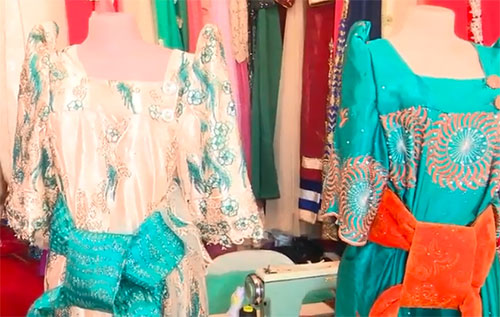 This folk dress is rather modern compared to other traditional outfits around the world. It appeared in the early 20th century. And the history of its invention is unusual and curious. This women’s attire invented by an outlander has found its place in the traditional clothing culture of Uganda. A gomesi or busuuti gown is bright, floor-length, and made from a large amount of fabric. Of course, such clothes mostly weren’t available to African females before the 1900s. Though, Ugandan women fell in love with these long and colorful dresses so much that they became Ugandan national costumes.
This folk dress is rather modern compared to other traditional outfits around the world. It appeared in the early 20th century. And the history of its invention is unusual and curious. This women’s attire invented by an outlander has found its place in the traditional clothing culture of Uganda. A gomesi or busuuti gown is bright, floor-length, and made from a large amount of fabric. Of course, such clothes mostly weren’t available to African females before the 1900s. Though, Ugandan women fell in love with these long and colorful dresses so much that they became Ugandan national costumes.
Gomesi or busuuti dresses are very popular in Uganda, especially among the ladies from Buganda and Busoga kingdoms. The garments are typically floor-length and brightly colored. They have a square or round neckline, short puffy sleeves, and a wide sash around the hips with the ends hanging to the floor. Also, there are 2 buttons on the left side of the neckline – they serve both as a fastener and as decoration.
Gomesi/busuuti gowns are always sewn from a large piece of fabric – up to 6 meters. Usually, it’s cotton or linen cloth, but silk is also popular, though much more expensive.
Sometimes, especially if a dress is made from linen, women wear a traditional undergarment as a basic layer – a rectangular piece of cotton called “kikooyi” or “kanga” – underneath the gomesi. It’s sort of a wrap-around skirt and it prevents the linen from sticking to the body in the African heat.
Most Ugandan females wear a gomesi or busuuti for festive and special occasions – weddings, funerals, large family celebrations, etc. But in rural areas, they often use it as day-to-day attire. By the way, there is a wedding tradition in Uganda called “kwanjula” when all of the groom’s female relatives must wear a gomesi.

Today, this colorful and eye-catching dress is rather popular in Uganda, but it appeared in the local clothing tradition not that long ago. A gomesi or busuuti gown was invented by Indian designer Caetano Gomes (thus the name of the dress) in 1905. Why would an outlander create a folk dress for another country? Let’s see.
At the time, Ugandan women wore an ancient traditional garment called “suuka” that looks like a strapless top, just a piece of cloth wrapped around the torso. And when Uganda was a British colony, an organization called the “Church Missionary Society” started building schools for African children. They didn’t consider suuka a proper garment, so they needed a new modest school uniform for girls. As India was also under British rule, it was Indian designer who managed to create a uniform that satisfied the British.
At first, the local women didn’t fall for this trend and these reserved dresses were only for schoolgirls. Only in 1914, when the local king’s wife wore a gomesi for her husband’s official coronation, the style gained real popularity. After this pompous event, many Ugandan women tried a gomesi on and fell for it. A gomesi quickly turned into the official folk dress of Uganda.
This is how geography and geopolitics can influence clothing culture. Who would have thought?!


